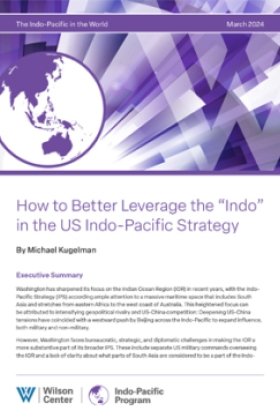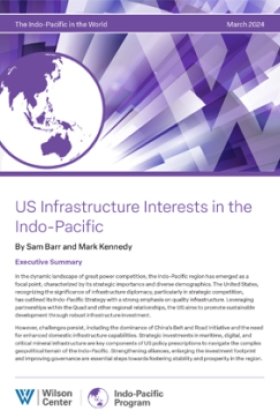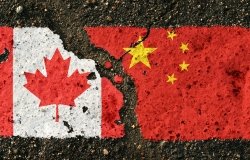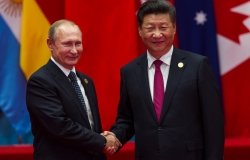Building a U.S.-China Energy Partnership
China and the United States are the world's biggest energy consumers, and both seek ways to reduce their carbon emissions to protect the environment. The Wilson Center's China Environment Forum is hosting a series of meetings to explore cleaner coal, renewable energy, and other bilateral energy efforts.
China and the United States are the world's top two energy consumers and also the largest carbon emitters. Both will play decisive roles in developing cleaner energy to protect the environment.
For nearly three decades, many U.S. NGOs, universities, and national labs working with Chinese counterparts have played a valuable role in energy policy formation in China. However, formal bilateral energy cooperation over the years was stymied by insufficient funding, low priority, and mutual suspicions due, in part, to inaction.
The benefits for both countries to press for low carbon development—job creation, economic growth, energy security, climate change, reduced pollution, and healthier citizens—create an opportunity for renewed U.S.-China energy cooperation. President Barack Obama and Chinese President Hu Jintao have invigorated this effort through a package of new energy agreements they signed last November that cover energy efficiency, renewable energy, and clean coal.
The Wilson Center's China Environment Forum (CEF) has launched a "Cooperative Competitors" series of meetings and research briefs that focus on U.S-China clean energy cooperation, thanks to funding from Blue Moon Fund and Rockefeller Brothers Fund, with additional support from USAID and Vermont Law School. Topics include alternative energy technologies; power sector reform; financing to promote clean energy; and challenges in monitoring carbon emissions.
Decarbonizing King Coal
"As the second largest energy consumer [behind the United States] China will need additional hydrocarbons and to expand its nuclear energy and renewable energy sources to fuel its target of 8 to 10 percent GDP growth rate per year," said Ambassador Richard Morningstar, special envoy of the U.S. Secretary of State for Eurasian Energy. At a May 4 Asia Program meeting, he said China recognizes the negative environmental impact of coal, which comprises 70 percent of its energy mix. He said natural gas produces only half the emissions of coal, thus "supporting the global objective to combat climate change."
Carbon dioxide emissions from coal-fired power stations are the single largest driver of global warming on the planet, accounting for roughly 20 percent of total human-made CO2 emissions. But coal is king, especially in the United States and China, which together produce half of the world's coal-fired power emissions, control almost a third of the world's coal reserves, and have built their energy sectors around large fleets of coal-fired generating stations. Coal use by China is expected to double in the next 20 years.
At a May 12 CEF meeting, panelists discussed how the Clean Air Task Force is working to accelerate zero- and low-carbon energy technologies by facilitating joint ventures between innovative energy companies in China and the United States. Ming Sung, chief representative for the Asia Pacific at the Clean Air Task Force, said "investments by one country can reduce the cost of a technology worldwide, increasing the likelihood that carbon-capture-and-storage (CCS) will be deployed widely in time to help avert the worst consequences of climate change."
The clean energy partnerships that Sung has facilitated involve a range of key U.S. and Chinese companies and institutions. He said, "Significant reductions in global energy greenhouse gas emissions will require a massive change in technology."
Another panelist at this meeting was Albert Lin of the Houston-based Future Fuels LLC, a company that integrates its gasification technologies, coal, and land assets to develop low-emission coal projects, liquid fuels, and methane. Future Fuels is the exclusive U.S. licensee of an advanced coal gasification technology developed by China's Thermal Power Research Institute. The gasifier, which allows the company to capture carbon emissions more easily and less expensively than it could at a conventional coal-fired plant, will be used at several Future Fuels power plants under development, beginning with the Good Springs Project in northeast Pennsylvania. This project will generate a tremendous amount of jobs in a region with high unemployment.
The U.S. and China: Clean Energy Relations
Companies in the United States and China are working to develop new, more cost-efficient manufacturing processes and increase their shares of the domestic and export markets. On both sides of the Pacific, cooperative initiatives to increase the capacity and reduce the cost of renewable energy technologies may produce benefits over the longer term by reducing the reliance on fossil fuels and helping achieve global carbon reduction goals.
On June 11, Wilson Center on the Hill and CEF co-hosted an event on Capitol Hill featuring two panelists from Bloomberg New Energy Finance, John Romankiewicz, a senior analyst for China Clean Energy and Carbon Markets, and Ethan Zindler, head of North American research.
Zindler said the end goal for China and the United States is to produce clean energy such as solar and wind power more cheaply than fossil fuel sources. He argued that such technologies are less likely to be implemented if they remain prohibitively expensive.
Another problem is the lack of demand in the United States. Romankiewicz said natural gas prices are down significantly, so it has become less realistic for many utility companies to develop the alternative energy sector. Electricity demand also declined over the last year, which took the pressure off of wind capacity. "The [U.S.] market is not looking hot for domestic wind and solar power," he said.
Romankiewicz pointed out that China's power grid has grown by more than 70 gigawatts per year during each of the past five years and the capacity of China's grid is expected next year to surpass that of the United States.
While coal and hydro power continue to play a significant role in meeting this growing demand, Romankiewicz noted that China also has set ambitious investment targets for wind farms, solar farms, biomass power plants, and other renewable energy sources.
China has already made impressive advances in clean energy industries: of the top 15 wind producers, 4 are Chinese while only 2 are American, and of the top 10 crystalline-silicon solar cell producers, 6 are Chinese. While China is poised to become a major player in exporting clean energy technologies, Romankiewicz argued, breaking into the American market could prove exceedingly difficult, given the stiff competition from domestic and foreign firms.
Zindler said the economic implications are far deeper than the obvious gains from manufacturing and exporting clean energy modules. "If the Chinese are helping to drive down the cost then they make solar less expensive which means you can create more jobs in California or New Jersey ." Romankiewicz urged caution when reading the "made in China" label on clean energy technologies, as the process chain can be global and complex, with parts coming from all over the world.
With an eye toward long-term benefits, Zindler also stressed the urgency in investing in clean energy technologies now. "I think a lot of opportunity would be missed potentially because there is innovation that doesn't just come from a lab, but comes from building newer and newer assembly lines," said Zindler. "This is a marathon, not a sprint. We've got a long way to go" before the United States and China can produce clean power at a lower cost than coal.
Decarbonizing China's Power Sector
At a June 24 CEF meeting, Federal Energy Regulatory Commission Chairman Jon Wellinghoff joined power sector experts Jim Williams, Fritz Kahrl, and Ding Jianhua from Energy and Environmental Economics to discuss the regulatory and institutional challenges facing China's power sector.
While the Chinese government has undertaken aggressive policies to improve energy efficiency and expand low-carbon generation, these efforts face many implementation challenges. They also offer a unique opportunity for deepening U.S.-China cooperation to create models, regulations, and technologies jointly to accelerate decarbonizing their electricity sectors.
Wellinghoff said power grids in China and the United States have similar challenges in expanding renewables, namely that plentiful wind and solar sources are inland, far away from booming coastal cities, and that market incentives to integrate renewables into grids are insufficient. While China has superior high-voltage grid transmission technologies, the United States has been developing demand-side management practices and markets to spur energy efficiency and renewable integration in the power sector.
Every speaker noted that mutual understanding of each other's power sectors could build more effective energy cooperation, which could have a major impact in lowering GHG emissions from these two energy-hungry nations.
Related Links
Related Programs

China Environment Forum
Since 1997, the China Environment Forum's mission has been to forge US-China cooperation on energy, environment, and sustainable development challenges. We play a unique nonpartisan role in creating multi-stakeholder dialogues around these issues. Read more

Environmental Change and Security Program
The Environmental Change and Security Program (ECSP) explores the connections between environmental change, health, and population dynamics and their links to conflict, human insecurity, and foreign policy. Read more










